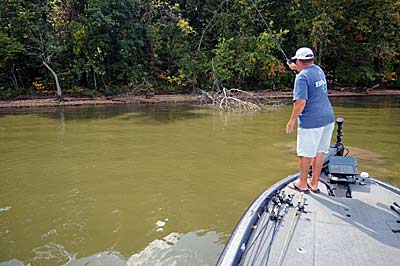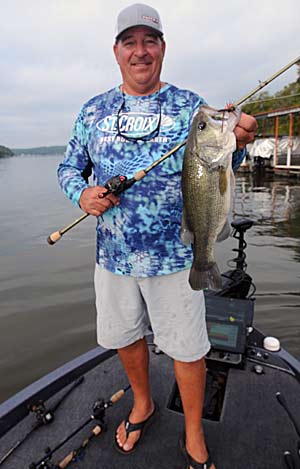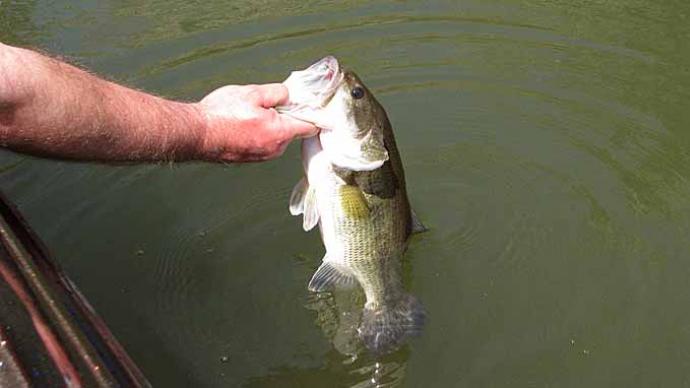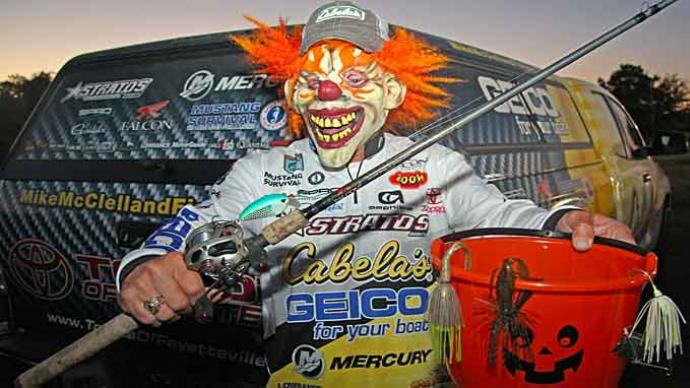
When autumn arrives, Dennis Berhorst runs away from "trout water."
During late summer and early fall, Berhorst starts running up the shallow riverine sections of a reservoir rather than fishing the impoundment's clear lower part, which he calls "trout water." The Missouri tournament competitor prefers the upper ends of reservoirs then because the water there has more color and is shallower, so it tends to cool down quickly. In contrast, the water on the lower end is usually gin clear and remains warm longer.
While most bass on the lower lake stay deep in early fall, bass in the upper shallow reaches become more active, triggered by baitfish movement, shortened daylight hours, and cooler nights. “The deeper bass (in the upper sections) start to get up on the bank, especially when the big gizzard shad get up shallow,” Berhorst says.
Even when the water temperature stays in the 80-degree range in the fall, Berhorst heads for the tributaries of a reservoir because most of the bass are always shallow. "There are deep fish up there, but because of the water color, you just don't fish for those bass," Berhorst says. The dirty water in the tributaries makes shallow bass less spooky than their lower lake cousins residing in the clear water.
Berhorst concentrates on the main channel of the upper reservoir in early fall and then keys on the pockets and coves as fall progresses. The 10-time Bass Fishing League (BFL) and Major League Fishing (MLF) Toyota Series winner catches upper reservoir bass 5 feet deep or less. "It's mainly power fishing, shallow-water fishing whether it is wood or docks or whatever," Berhorst says. "It is typically better in the afternoons than in the mornings. The sun gets up high and positions the bass to where you can catch them." The sunshine pushes bass to the shady spots along docks, laydown logs, or in brush piles where the fish hold tight to the cover.

Weather dictates the types of lures Berhorst throws to upper reservoir bass. “A jig and a worm are both real good," he says. Some of his other favorite lures for tributary bass are a Chatterbait, squarebill crankbait, and topwater lures such as Whopper Ploppers and Zara Spooks.
Fast-moving lures produce best for Berhorst in cloudy weather or sunny, breezy days. His favorite action lures are a white 3/8- or 1/2-ounce Chatterbait, shad-colored or bright white Strike King KVD 1.5 or Dave's Custom Baits 2.5 square bill crankbait and bone-colored Zara Spook or Whopper Plopper. The eight–time BFL All American qualifier throws the Whopper Plopper for aggressive bass and the Zara Spook for less active fish.
Berhorst’s main lure for fishing on calm days with bluebird skies is a 3/8- or 1/2–ounce black-and-blue or brown flipping jig tipped with a blue sapphire or green pumpkin Zoom Z-Craw trailer that he pitches to wood cover and docks. When he wants to present a different look to bass, Berhorst pitches a Texas-rigged black or green pumpkin 7 1/2-inch straight-tail plastic worm on a 5/0 Gamakatsu Super Line Extra Wide Gap Hook and a pegged 1/4-ounce worm weight.
While upper reservoir bass can be easier to catch in the early fall, certain factors can affect the shallow water bite there. "Anytime there is a cold front, it usually shuts the bass down,” Berhorst says.
Current also plays a factor, especially if the upper reservoir has a dam above it. "Current always makes bass bite a little bit better," Berhorst says. He notes that tributaries with a steady flow into the upper end of the reservoir have bass that bite at any time. In contrast, a dam above the upper end of a reservoir causes bass to feed better when the dam releases water to create current.
The fall turnover also affects the upper reaches of a reservoir faster than the lower end. "It is a small period where it is tough fishing, but before the turnover and right after the turnover is always really good," Berhorst says. He avoids fishing the turnover by looking for other areas unaffected by the fall phenomenon.
Fishing pressure also negatively affects the bite on the upper reservoir. "The river area fishes small because there is not much water there, but you can go up there then and grind it out fishing creeks and pockets, wood and docks and whatever and still catch some bass,” Berhorst says. “It is hard to catch big sacks consistently in a multiple-day tournament, but you can still go up there and catch 17 or 18 pounds in one day.”
Heavy rain in the fall can positively affect the upper reservoir fishing. Berhorst notices rain runoff brings in dirtier water, which becomes a magnet for bass. His favorite rain runoff lures include a red squarebill crankbait, red Rat-L-Trap, or a white-and-chartreuse 1/2-ounce War Eagle spinnerbait with bronze or copper willowleaf blades.
When late fall arrives, and the water temperature dips to around 50 degrees, Berhorst moves down the lake to clearer water because it gets too hard to catch bass in dirty, cold water on the upper end. However, if an Indian summer lingers throughout the fall, Berhorst continues to fish the upper reservoir and avoids the "trout water."




